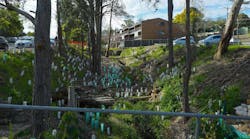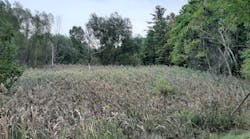Bioengineering and Reinforced Vegetation
Thousands of streams and rivers in West Virginia and throughout the nation have problems with severely eroded banks. This soil erosion generates hundreds of thousands of tons of sediment and is considered the largest water-quality problem in the US. This sediment results in the increased cost of treating drinking water, and the destruction of fish and wildlife habitats. Swimming and fishing holes are filled, and trees are uprooted, allowing dangerous undercuts to be created on streambanks. Damages from flooding can worsen when a stream fills with earth, reducing its water-holding capacity. High stream flows result in more frequent out-of-bank events, and redirected water often threatens homes, buildings, farm fields, lawns, pipelines, and roads.
Human activities contribute to the problem, including road construction, railroads, agriculture, natural-resource extraction, and even small things such as lawn landscaping. The two major factors causing excessive erosion are alteration of the stream channels and streambank, such as widening, deepening, or moving, and the removal of vegetation, especially trees and shrubs, along streambanks.
In recent years, technology has been developed using geosynthetic materials and earth anchors to stabilize failing and newly graded slopes. These systems are known as anchored reinforced vegetation systems (ARVS). Generally, they consist of uniquely shaped polypropylene fiber yarn woven into a turf reinforcement mat (TRM). The unique shape allows the matrix to capture and retain moisture, soil, and seed. This system, installed with earth anchors, has a field-tested pullout capacity of 500 pounds with a minimum of 24 inches depth. One of the advantages of the polypropylene fiber is its longevity. According to Propex, the manufacturer of the system used, the system is designed for approximately a 50-year lifespan, during which it will break down by 75%, or 1.5 % per year. This allows time for root systems to establish and develop a natural vegetation reinforcement system. Unlike traditional hard armoring techniques, an ARVS is lightweight, does not surcharge weak foundation soils, and is easy to maintain without heavy equipment and personnel. These systems have been traditionally used in nonagricultural situations, including at the Gordy Pumping Station by the US Army Corps of Engineers in New Orleans after it was breached during Hurricane Katrina, as well as at sites along the Pennsylvania Turnpike, and by the New York and California departments of transportation. This article describes demonstration projects conducted by the West Virginia Conservation Agency to control excess streambank soil erosion along pastureland, using a combination of ARVS and soil bioengineering techniques. Soil bioengineering is the use of live and dead herbaceous and woody plant materials in combination with natural and synthetic support materials for slope stabilization, erosion reduction, and vegetative establishment. Although often thought of as a new technology, these practices have been used for many years-as early as the 1930s by the US Forest Service.
Methodology
To install the systems, all banks were sloped to either 2:1 or 3:1. Seed and fertilizer were applied to the slopes at appropriate rates to the site. Where compost was available, no fertilizer was used, and compost was spread over the top of the TRM. Tree revetments or fiber rolls were installed at the toes of the slopes to protect them and anchor the TRMs. The TRMs were unrolled in a shingling manner, starting at the downstream end of the eroded banks. Twelve-inch pins and 24-inch earth anchors were placed at the frequency and spacing required to tie down the TRM. This was typically a diamond pattern for the anchors and as needed with the pins to prevent tenting (Figure 1). Where trees were planted into the system, pins were used to prevent high water from floating the TRM. Edge trenches were installed longitudinally on the first and the last rolls of the project. All seams overlapped approximately 6 inches.
The earth anchors were installed by a rod fitted with the anchor being driven through the TRM approximately 24 inches (Figure 2). The cable attached to the anchor was then pulled, allowing it to set parallel to the soil surface. A secure plate was then cinched down through the cable tight against the soil surface. A copper sleeve was then crimped to hold the plate in place.
To calculate the soil loss and efficiency of the system, several different calculations were used. To calculate the soil volume that would erode if the site had not been treated, the volume of the area was estimated from landowner information about how much land is lost each year. These figures were calculated using the formula for determining the volume of a pyramid (area of base multiplied by one-third of the height). After the area was sloped, the Revised Universal Soil Loss Equation (RUSLE) was used to determine soil loss by sheet and rill erosion. C values used for RUSLE were 1.00 before practice instillation and 0.01 after instillation and vegetation establishment. When RUSLE was calculated prior to revegetation, the results were similar enough to that of the volume of a pyramid that it was decided RUSLE could be used as the efficiency indicator for the system. Efficiency of the system was calculated by the percent difference soil lost before and after the system was installed.
Site Specifics and Results
Anthony Creek, Greenbrier County-The first site is located on the Greenbrier and Pocahontas county line. At this site, Anthony Creek was eroding an area of pastureland at a rate of 30.6 tons of soil per year, according to RUSLE. The soil on this site is a Potomac very gravelly fine sandy loam with a tolerable (T) soil-loss rate of 3 tons per acre per year and an erodibility factor (K) of 0.24. During construction, the streambank was sloped to a 2:1 grade, removing 50.31 tons (37.30 cubic yards) of unstable soil from the streambank. This soil was placed in an upland location and stabilized from future erosion.
The site is 170 feet long and was stabilized using a high-performance TRM and earth-anchor system, commercially known as the ArmorMax system. A tree revetment utilizing onsite materials and rock from a local quarry was used to stabilize the toe of the bank and anchor the TRM. Seedling trees were planted into the TRM. Compost was used to cover the TRM, applied both over the top of and underneath the mat, to provide organic matter and encourage seed germination. Grass was planted. The site covered 2,222 square feet, and the cost for the system was $9,228.75 ($4.15 per square foot, or $37.37 per square yard). According to RUSLE, the new soil loss rate after the instillation of these practices is 0.33 tons per year (98.91% less than before).
To achieve the same soil-loss results at this site using riprap, the total cost of the project would have been $11,021.12. Utilizing 183 tons of rock and twice as much labor, the cost would have been $4.96 per square foot.
Another comparison was also conducted to determine the effect of the TRM on the overall system. If all factors of the installed system stayed constant, except that the TRM was not used and instead hay mulch was used at a rate of 0.5 tons per acre, the overall efficiency of the system would be reduced by 26.35% and the cost would be reduced to $1.69 per square foot. According to RUSLE, the annual soil loss for the site would be 8.37 tons per acre per year. This would not be enough protection to bring the soil loss for the site to tolerable a level.
Cow Creek, Pleasants County-In Pleasants County, Cow Creek was eroding an area of pastureland at a rate of 41 tons of soil per year according to RUSLE. The soil on this site is a Gilpin-Upshur complex with a tolerable (T) soil-loss rate of 3 tons per acre/year and an erodibility factor (K) of 0.32. On this site, the streambank was sloped to a 3:1 grade, removing unstable soil from the streambank, and 462 tons of soil was placed back into the bends of the stream to reestablish the original pattern of the channel.
The total site length is 300 feet. It was stabilized using two types of erosion control devices. The high-performance TRM and earth anchor system known as ArmorMax was used in the 90-foot section of the bank that receives the most stress from high water. The remaining 210 feet were covered with a straw erosion control blanket. Coconut-fiber logs were installed at the toes of the slopes to anchor the bottom of the mats and to prevent undercutting of the system. Grass was then seeded to establish permanent cover. The site covered 630 square feet, and the cost was $4,552.35 ($7.22 per square foot or $64.98 per square yard). According to RUSLE, the new soil-loss rate after the installation of these practices is 0.71 tons per year (98.47% difference than before initialization). To achieve the same soil loss results for this project utilizing riprap, the total cost of the project would have been $6,144.65. Utilizing 51.97 tons of rock and twice as much labor, this would have cost $9.75 per square foot.
Discussion
When determining the overall efficiency of the practices, ARVS actually installed was compared to hypothetical riprap and mulching practices on the same site where the ARVS was installed. RUSLE was then used to determine the soil loss before and after bank treatment post sloping. The percent difference is utilized as a percent efficiency of the practice (Table 1).
While significantly less expensive than ARVS and riprap, mulch on the Anthony Creek site would have been 26.26 % less effective and still not have reduced erosion to tolerable levels. Riprap on the other hand is just as effective on soil erosion as ARVS but is 19.5% more expensive. Riprap and ARVS both provide immediate protection against mass erosion and sheet erosion if a sudden high-water event would occur before vegetation is established. ARVS also provides the ability to vegetate with trees to develop habitat and shade over the stream.
Conclusion
Anchored reinforced vegetation systems provide an economical alternative to riprap and enhance traditional soil bioengineering techniques. The TRM provides immediate protection from sheer stress of overland and concentrated water flow, and there are also habitat, water-quality, aesthetic, and increased safety values that cannot be calculated monetarily. Additionally, the lack of labor and equipment necessary to install this type of system makes it ideal for the agricultural community, which traditionally has limited resources to work with.
The ability to hold soil at the same efficiency as a riprap system and also establish an effective riparian buffer could be the most attractive trait of the ARVS. The anchoring system reduces the total weight and compaction on the streambank soil, allowing for proper root growth and diversity of vegetation establishment. In addition, the ability to plant trees into the system allows a canopy to overhang the stream, reducing sunlight and cooling the water to allow for higher dissolved oxygen potential and improved fish habitat. This also reduces the likelihood of algae blooms in the pool adjacent to the practice, thus preventing a high biological oxygen demand. Additional research and demonstration work may have to be conducted to determine other TRM material that can be used in these types of systems, and different seed mixtures should be experimented with to determine the most effective. While ARVS are less expensive that traditional riprap, the expense of the system may be enough to deter landowners from working without government cost share and lead them to utilizing a less-effective system. While the cost figures for this demonstration may have been arbitrarily high due to the equipment used, it is believed that, by using smaller equipment, the total cost of the ARVS could be cut almost in half. Nevertheless, more demonstration is needed to come to this conclusion.
This project was funded by Clean Water Act 319 Nonpoint Source funds in conjunction with the West Virginia Conservation Agency and the West Virginia Department of Environmental Protection.


